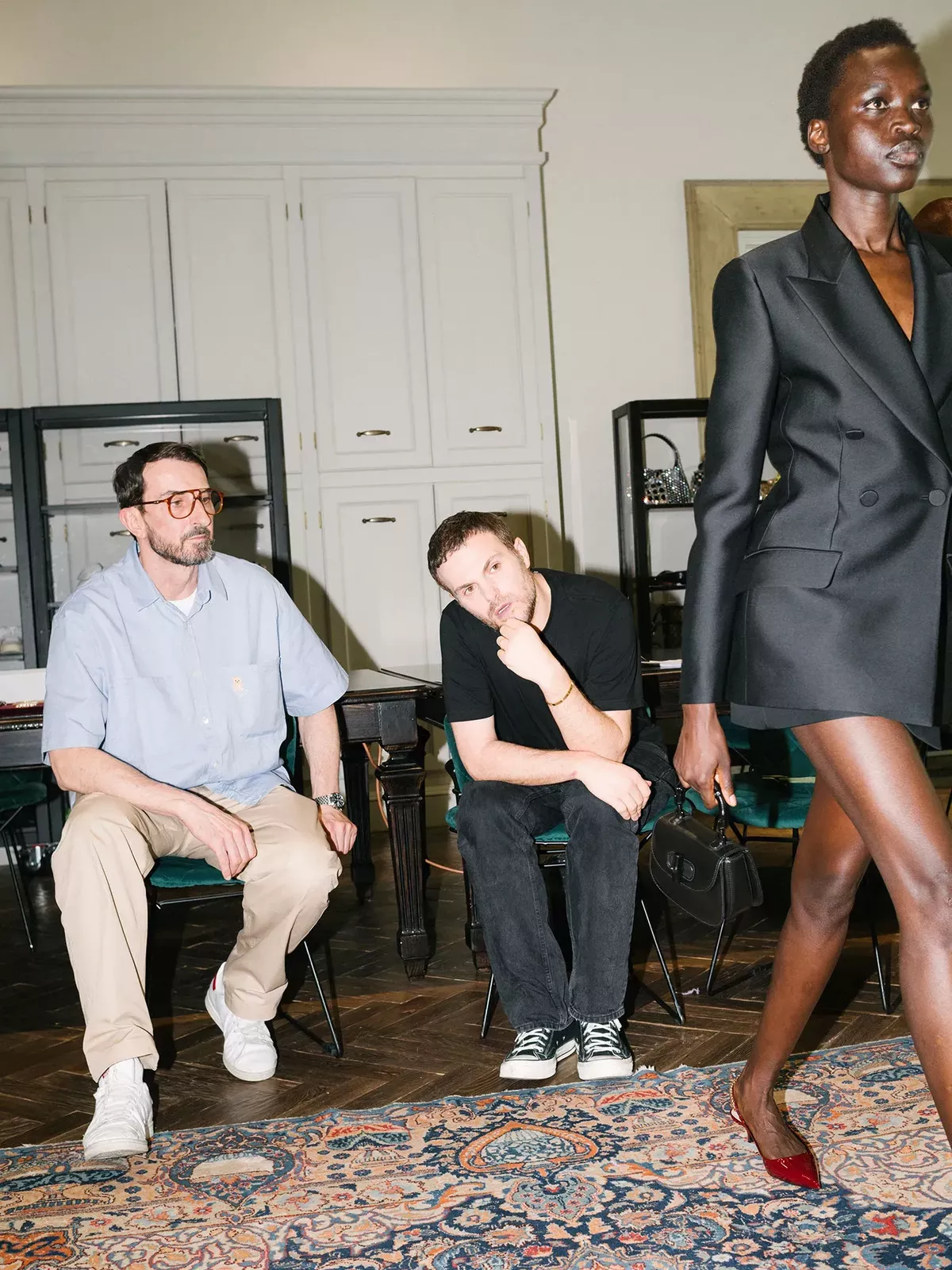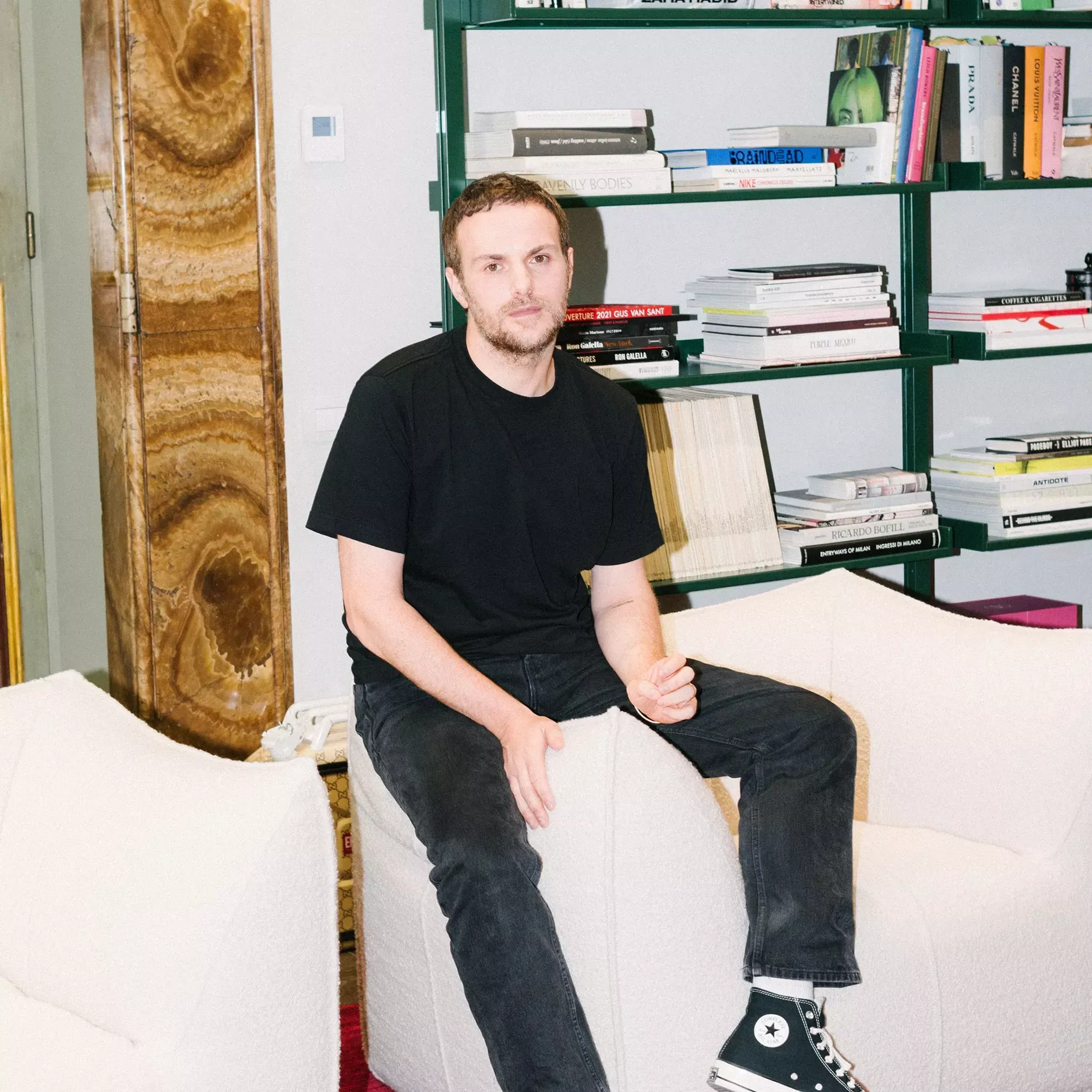The designer will step into the spotlight with his debut show as Gucci’s creative director on Friday, which will mark the beginning of Gucci’s next chapter
“My first appointment with fashion was with Gucci.”
Sabato De Sarno is sitting on one of four Mario Bellini Le Bambole chairs in his Roman office with his dachshund Luce perched on his lap. It’s been “one month and 10 days” since he took over as creative director of Gucci, the $10 billion Kering brand. The little dog has made herself right at home in Gucci’s 17th-century Palazzo Mancini-Salviati headquarters, but De Sarno, a boyish 40 with a sensitive, thoughtful nature, is still feeling his way around – getting to know the teams, running product tests, and sitting down for introductory interviews like this one. He starts with a personal story about an early fashion purchase.
“I took the train to Rome, it was my first time in a luxury store,” he says on the July day we met. “I remember what surprised me was to see the people in the queue outside. I think I felt like my nephew does when I go to Disney with him now. It was emotional. When it was my moment to go in, I bought this jacket, a Tom Ford jacket. Velvet, deep red, with a black collar. I sold the necklace that my parents gave me to buy it. They don’t know that.”
Today he has a uniform of black T-shirts, black jeans and white Converse All-Star high-tops, but he still owns that Gucci jacket. “Now it’s very small for me,” he says. “I was a young guy, but I still have it because I love it.”
A graduate of Milan’s Istituto Secoli, with stints at Prada and Dolce & Gabbana before a decade-plus run at Valentino, De Sarno has been in fashion for 20 years, but prior to Gucci he worked behind the scenes and he was comfortable there. “This is a very new moment for me,” he says. “I’m a dreamer, but honestly I’ve never dreamed of something like this.”
By the time he bought the jacket, De Sarno knew he wanted to be a fashion designer. “I grew up in a small village in the south called Cicciano close to Naples,” he says. “And I was very interested in what people were wearing in the streets because it’s the first way that you communicate to other people who you are. This is when I started to think about creating clothes, because it’s about helping people to be themselves.”

De Sarno, surrounded by his team and models wearing looks-in-progress. Photo: Federico Ciamei
Encouraging his team to be themselves was one of his first tasks at Gucci. “I called everyone into my office, and I said I know I’m your creative director, but I’m Sabato and I was in your position only 20 days ago and I know what you’re thinking, and why you aren’t saying anything. I know you’re scared because a lot of things are changing and you feel part of the old Gucci. But now you are here, and if you are here, you are my team, and I need your opinion.” During our July visit, De Sarno’s closest allies appear to be Remo Macco, a Gucci veteran who was named the studio design director last year, and artistic director Riccardo Zanola, with whom he worked previously at Valentino.
De Sarno earned the trust of Valentino’s Pierpaolo Piccioli over a span of 14 years, rising from head of knitwear for men and women in 2009 to become his right-hand man. The going-away party Piccioli threw for him at the end of April, with everyone wearing I ❤ SdS T-shirts, made the rounds on social media. High fashion isn’t accustomed to such public displays of emotion. Of his former boss, De Sarno says, “We’re not similar, but we have a lot of things that we share and we think in the same way. To me this is important: I can’t stay in a place where I don’t feel I can be myself, because I lost a lot of time when I was a teenager not being myself.” He says he didn’t come out as gay until he left home for school in Milan. It was the first place where he “felt free”.
I’m a dreamer, but honestly I’ve never dreamed of something like this.
Sabato De Sarno
When Kering announced his appointment in January, Marco Bizzarri, the company’s then-CEO, said De Sarno was hired to “write Gucci’s next chapter, reinforcing the house’s fashion authority while capitalising on its rich heritage”. The word the designer uses for his take on Gucci is Italianity. Gucci, he says, “It’s a very Italian brand with a huge heritage. Italian in craftsmanship, Italian in taste, and we lost that I think. I want to bring it back. Italianity is part of my story, for sure.”
Some designers are artists and some are engineers; De Sarno proudly belongs to the latter category. He chose the Istituto Secoli (then called the Istituto Carlo Secoli) because it offered the most technical training. “The other schools just suggested I draw inspirations for a moodboard. I wanted a school where I could learn skills.” At Prada, an internship led to a full-time job, and he worked in the pattern maker Delia Coccia’s office, turning 2D sketches into 3D garments. “She was a maker of coats and that’s why my passion today is coats. I collect them because she was the best in Prada.”
If eccentric is the adjective Gucci watchers reached for under the brand’s former creative director Alessandro Michele, essential seems better suited to De Sarno’s version. His Gucci debut is likely to open with a coat, minimal in cut and construction and made from a crisp wool, with the house’s trademark striped grosgrain ribbon trimming the vent in the back, an unobtrusive but unmissable marque. “I started from the wardrobe, because I felt the urgency to put together the pieces that I like and that I don’t find,” he says. “Yes, there are a lot of coats around the world, but this is my coat, my shape, my fabric, my detail.” The overall silhouette of the collection, in keeping with much of what we’ve seen this season in New York and London, is short and leggy. De Sarno’s minis come with built-in shorts that peek below the skirts’ hems. “It creates confidence,” he says. The classic Jackie bag will be making a comeback, but in a softer leather “to make it more everyday”, and the Bamboo bag, too.
In a departure from recent status quo, this season’s Gucci show will not take place at the Gucci Hub, the sprawling headquarters on the edge of Milan that opened in 2016. Instead, De Sarno has chosen the streets surrounding the Accademia di Brera, a historic fine arts university, where the designer imagines people lining the balconies to watch as the models walk by. Tunes by Mark Ronson, the Gucci show’s official music director whose most recent work includes the Barbie soundtrack, might even get them dancing.

De Sarno sits with Remo Macco, a Gucci veteran who was named the studio design director last year, during a fitting. . Photo: Federico Ciamei
Art plays a big role in De Sarno’s life. Gallery hopping is one way he and his husband Daniele, who is a lawyer and lives in Brussels, spend their weekends together, but he started collecting before they met, when he was “very young”. He leans towards work with words, work that “makes you think”, as he puts it. The piece behind his desk that reads “Everything is great / Everything is shit / Everything is boring / Everything is alright / Everything is fucked / Everything is sexy / Everything is dull” is by an emerging Chicago artist, Eric Stefanski, and he namechecks Lucio Fontana, “not because of his colours or his sliced canvases, but because of the personal notes he wrote on their backs”. If he were to do like Fontana and put words in the lining of his show-opening coat, what would they be?
“I want it. I desire it,” he says. “I want people to fall in love with Gucci again. That’s why I use the word ‘ancora’ for my show.” De Sarno has the Italian word printed in a frame on the wall next to his desk. He also had it tattooed on his left arm after he got the Gucci job (on his right is an Ellsworth Kelly calla lily from when he was 18). “Ancora means a lot of things,” he explains. “It means again, but it’s also more personal; it’s not something you lost, it’s something that you still have, but you want more of it because it makes you happy.”
De Sarno made the internet happy when the first image from the jewellery campaign was released on 5 August, and Daria Werbowy was its star. Werbowy dominated the runways in the 2000s before walking away from modelling in 2013, but she came back for her old friend Sabato. The pair met 20 years ago, when De Sarno was earning his chops at Prada. “Daria, we started together in this business in 2003, and here you are with me at the beginning of this new adventure,” he wrote on the Instagram post accompanying the ad, in which she wears a black bikini bottom with interlocking double Gs at the hip and gold hoop earrings from the company’s high jewellery collection. On his Stories, he posted a two-decades-old snapshot of the two of them together, De Sarno’s curls and Werbowy’s bleached eyebrows serving as markers of the time that has passed.
For his runway show this Friday, De Sarno and his casting director Piergiorgio Del Moro are focused on new faces. “I would love to have unknown people,” the designer says. “I want to show an aesthetic, and if I use famous people you only see them. I’m not sure if they’d help me tell the story I want to tell.” De Sarno understands that Gucci is “a microphone to say things”, and one thing he’s shouting about is young talent. Concurrent with his runway debut, Gucci is sponsoring a gallery show of four young Milan-based artists not far from the Accademia di Brera venue of the show; the exhibition is open to the public and is accompanied by a publication, Gucci Prospettive N.1, Milano Ancora, that De Sarno describes as a “love letter” to Milan.
In late July, Kering announced a corporate shakeup. Second-quarter sales at megabrand Gucci had risen 1 per cent to €2.5 billion, below consensus expectations of 4 per cent. However, chairman and CEO François-Henri Pinault, acknowledging the executive changes that had been put in place, said, “the potential of Gucci, in my opinion, is above €15 billion”.
Bizzarri was to exit in September, the day after De Sarno’s show, and Jean-François Palus, formerly the Kering Group managing director, would succeed him. The reorganisation could have proved destabilising for a first-time creative director, but when De Sarno hops on the phone a week before his show, he tells a different story. “It was a big change, for sure, but not for me because I’m quite new. I feel like this is a bigger evolution now; all the key people, we are all new.” There’s a lot riding on De Sarno’s shoulders, but he’s ready. “I’m so excited,” he says. “I know the process because it’s part of my work, but the emotion behind this, it’s indescribable.”
Originally published on Vogue Business.
